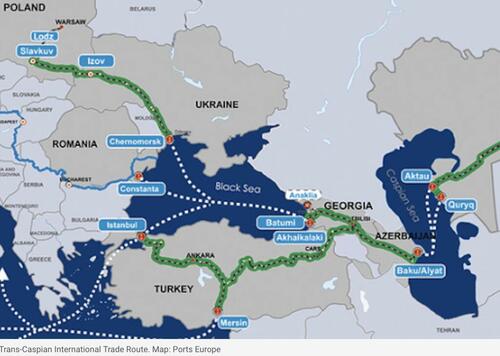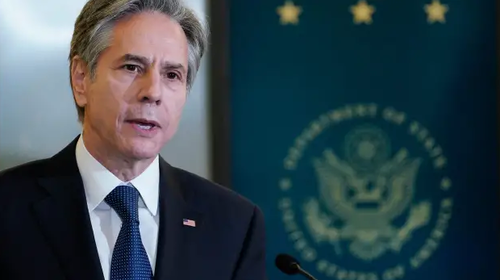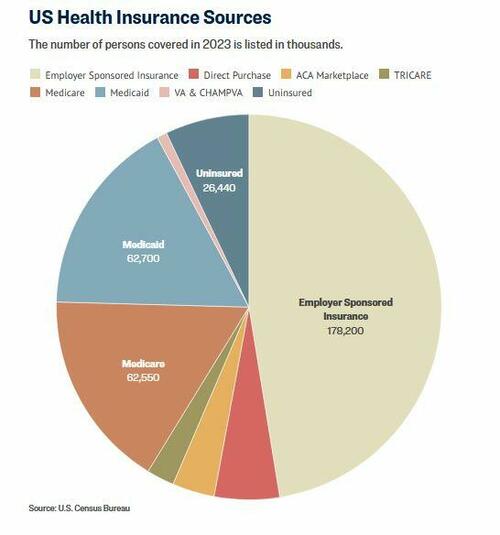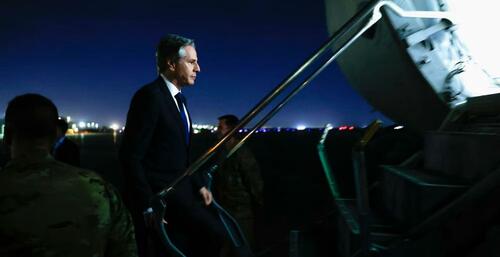Authored by Conor Gallagher via NakedCapitalism.com,
There are plenty of theories of what brought down Azerbaijan Airlines flight J2-8243 on Christmas Day. The plane, which was traveling from the Azerbaijani capital Baku to Grozny in the Russian region of Chechnya, ran into trouble over Russia and made an emergency landing in Aktau, Kazakhstan, in which 38 of the 67 people on board were killed.
The black boxes from the aircraft are currently being analyzed at Brazil’s Center for Investigation and Prevention of Aeronautical Accidents, but what’s already clear is that some have already made up their minds that Russia is responsible. Media in the US and Europe were of course quick to point the finger. That’s unsurprising; they blame Moscow for every stubbed toe and spilt coffee.
What is surprising is that the president of Azerbaijan — whose country has maintained strong ties with Russia despite the with-us-or-against-us Western pressure in recent years — is on the same page as the Western media.
That marks a major shift. Regardless of whether the alleged downing of the plane was part of a new stage of provocative pressure against Moscow, an accident with Russian air defense missiles, or was some sharp-winged birds, it does appear to be doing real damage to the Azerbaijani-Russian relationship.
And that could have major implications for the South Caucasus where the pivot state of Azerbaijan is the most important transport and logistics hub in the region.
Let’s take a look at what the Azerbaijan president is saying about the incident and examine what it might mean for the region.
Aliyev’s Statements
Azerbaijan President Ilham Aliyev was once described in a Wikileaks US diplomatic cable as an unpredictable hothead similar to Sonny Corleone, but he has been anything but in recent years. While calmly playing both sides, he’s managed to retake Nagorno-Karabakh (whatever one may think about the method), become a major gas supplier to the EU, and maintain strong ties with Moscow and workable relationships with other players in the region.
His comments about the plane crash therefore raise eyebrows.
Before the black boxes are analyzed, Aliyev is putting the blame on Russia, which he says accidentally shot down the plane, continued to use electronic warfare against it afterwards, and then tried to cover it up. He might end up being right, but these are still bold proclamations coming from the president who just recently stood by Azerbaijan’s alliance with Russia. Here are the relevant quotes from his Dec. 29 interview with Azerbaijan Television at Heydar Aliyev (Ilham’s father) International Airport:
The facts indicate that the Azerbaijani civilian plane was damaged from the outside over Russian territory, near the city of Grozny, and almost lost control. We also know that means of electronic warfare put our plane out of control. This was the first impact on the plane. At the same time, as a result of fire from the ground, the tail of the plane was also severely damaged…
The fact that the fuselage is riddled with holes indicates that the theory of the plane hitting a flock of birds, which was brought up by someone, is completely removed from the agenda. It is possible that when the plane was damaged, when it was hit, the pilot could have perceived it as a collision with birds. Because it would probably never have occurred to anyone that our plane might be fired at from the ground while flying over a country friendly to us. Unfortunately, however, some circles in Russia preferred to put forward this theory. Another regrettable and surprising moment for us was that official Russian agencies put forward theories about the explosion of a gas cylinder on board the plane. In other words, this clearly showed that the Russian side wanted to cover up the issue, which, of course, is unbecoming of anyone. Of course, our plane was hit by accident. Of course, there can be no talk of a deliberate act of terror here. Therefore, admitting guilt, apologizing in a timely manner to Azerbaijan, which is considered a friendly country, and informing the public about this – these were measures and steps that should have been taken. Unfortunately, for the first three days, we heard nothing from Russia except for some absurd theories…
Some believe that the plane was deliberately sent off course by ground handling services in Grozny because the plane was already out of control, and there was a high probability it would fall into the sea. If this had been the case, the cover-up attempts would have been successful, and the so-called bird theory would have been presented as the most likely version…we can clearly say today that the plane was shot down by Russia. This is a fact, and no-one can deny this fact. Again, we are not saying that this was done intentionally, but it was done.
Strong accusations. Notably Aliyev does not once mention Ukrainian drones, which were being launched against civilian infrastructure in the region at the time of the plane downing. That might help explain how Russia accidentally shot at the plane — if that’s indeed what happened. It’s unclear why Aliyev doesn’t mention the possibility that shrapnel from a Ukrainian drone could have caused the damage to the plane.
While Aliyev no doubt has public opinion to worry about after such an awful incident, is it not odd that even if his theory is 100 percent correct, he wouldn’t at least try to soften the blow against his ally Russia and present Ukraine as at least partially responsible? Instead Kiev is largely getting a free pass as public anger is directed at Moscow.
For what it’s worth, Aliyev’s theory of what happened is the same as US officials quoted in American media. Both could be right, although Western media no doubt have an interest in using the incident to drive a wedge between Baku and Moscow.
The question is whether Aliyev is on board with that potential outcome? Could he be looking to play an Erdogan role where he utilizes leverage over Moscow in a similar way that Ankara has?
Viewing Aliyev’s Comments Against Backdrop of Recent Events in South Caucasus
Aliyev’s being so quick to forcefully blame Russia is a bit of a Sonny Corleone reaction, especially for someone who’s played his cards carefully in recent years. Could recent events in the Caucasus help explain his shift? Let’s examine the terrain:
Russian influence has come under increasing pressure there since the start of the Ukraine war.
Georgia looks to have fought off a color revolution attempt for now. Again it’s important to note the ruling party in Georgia is not anti-US or EU, it simply wants to maintain good ties with Russia and not be turned into another Ukraine.
In Armenia it’s another story. It continues to move out of Russian orbit politically if not economically. A US military officer is now the main adviser to Armenia’s defense ministry, the French are training Armenian units and signing weapons deals, and India has replaced Russia as Armenia’s top arms supplier. Yerevan is also seeking security guarantees from Brussels and Washington.
Moscow is observing the Azerbaijan-Armenia peace process from the sidelines (it used to lead the talks), although it still seemingly exerts quite a bit of influence over Baku. The two sides are nearing the conclusion of bilateral negotiations on a peace agreement that could have major implications for connectivity at the Eurasian crossroads. Simultaneously, Türkiye and Armenia are working to normalize relations, a process that Ankara ties to Armenia’s talks with Baku.
The US has weaseled its way into these processes via Armenia and is looking to exploit the situation to weaken Iran and Russia.
There are hang ups to deals between Azerbaijan, Türkiye, and Armenia, including Baku’s demand that Armenia remove an implicit claim on Nagorno-Karabakh in its constitution.
The most challenging issue in Armenian-Azerbaijani talks, however, is the establishment of transport links and specifically who will control them.
The Battle for Control Over Logistics Corridors in the South Caucasus
The so-called Zangezur Corridor – which would stretch parallel to Armenia’s border with Iran and link Azerbaijan to its Türkiye-bordered exclave of Nakhchivan — is the missing link in what would be the shortest land transport route between the Pacific and Atlantic oceans. And key to many involved parties is not only the shorter distance but the fact that it’s one of the few routes that entirely bypasses Russia.
The corridor would also be a key intersection point of other burgeoning North–South and East–West routes.
The Middle Corridor, for example, which passes from China through Central Asia, the Caspian Sea, the South Caucasus, and Türkiye extending to Europe could see major upgrades with the opening of Zangezur.

And so outside involvement and pressure steadily builds on Armenia and Azerbaijan .
The main issue holding up talks between the two is Point 9 of the trilateral statement signed between Azerbaijan, Russia, and Armenia in 2020 following the Second Karabakh War, which reads:
All economic and transport links in the region shall be unblocked. The Republic of Armenia shall guarantee the safety of transport communication between the western regions of the Republic of Azerbaijan and the Nakhichevan Autonomous Republic with a view to organize the unimpeded movement of citizens, vehicles and cargo in both directions. Control over transport communication shall be exercised by the Border Guard Service bodies of the FSS of Russia.
Azerbaijan continues to insist upon this point, while Armenia no longer wants Russian border guards present, and instead argues for solutions like Russia monitoring the corridor from afar. How exactly that would be done isn’t yet clear.
The Armenian prime minister is making statements about entrusting Zangezur’s security to foreign private forces. These ideas are coming as Armenia removes Russian border guards.
On Wednesday at Armenia’s request, the Russians withdrew from the only official Armenian-Iranian crossing, which followed the departure of Russian border guards from Yerevan’s Zvartnots Airport in July,. Since 1992 Armenia’s borders with Türkiye and Iran have been the responsibility of Russian troops.
Meanwhile, the number of EU guards on the Armenia-Azerbaijan border keeps expanding.
Both Azerbaijan and Russia are critical of the EU mission creep, and Baku continues to insist that Yerevan agree to the deployment of Russian border guards along the Zangezur Corridor.
Could that be changing?
Any agreement between Baku and Yerevan (and its Western backers) that excludes Russia would be a major power play from the Turkic axis and a perceived win for the US-Israel axis as it would sideline Russia and Iran.
How the latter two would respond remains to be seen, but what’s clear is how the Middle East conflicts and Ukraine war are bleeding into the Caucasus. It’s easy to see how it could become part of a deal that helps temporarily ease the tensions among the conquering parties of Syria by continuing to focus on areas on overlapping interests or get dragged in nonetheless.
Here’s a brief look at key players positions in this theater of The Great Game:
Iran
Pretty straightforward:
From Iran’s perspective the Zangezur Corridor is a nightmare. Neocon think tanks in Washington have long dreamed of using Azerbaijan to destabilize Iran — as they have for weakening Russian influence in the South Caucasus. Ethnic Azeri citizens who are estimated to make up 15 percent of the Iranian population.
Tehran’s concerns about Azerbaijan are further aggravated by Tel Aviv’s support to Azerbaijan (more on that below). Tehran also faces the following economic fallout from the Zangezur Corridor, according to Security & Defence Quarterly::
-
Azerbaijan used to pay 15 percent of the 350 million cubic metres of gas sent to Nakhchivan through Iran as a transit fee. With the opening of the new corridor, Iran may lose this profit.
-
An agreement on sale of gas was signed between Türkiye and Iran in 1996. Based on that agreement, Türkiye has been buying gas from Iran for years. While Türkiye pays Iran US$490 for a thousand cubic metres of gas, it can buy the same amount from Azerbaijan for US$335.
-
If a gas pipeline is built from Azerbaijan to Türkiye through this corridor, Iran’s loss of gas revenue may be huge.
-
The planned gas pipeline project from Turkmenistan through Iran to Türkiye then to Europe was frozen in 2017 because of financial disagreements. Turkmenistan can now deliver this gas to Europe via Azerbaijan.
-
The importance of Iran’s pipeline to Armenia has also decreased.
The Strategic Council of Foreign Relations in Tehran, whose director is Iran’s former minister of foreign affairs Kamal Kharazi, condemned the construction of the Zangezur corridor, indicating that the corridor has been introduced as NATO’s “Turan corridor,” a project ostensibly supported by Israel and NATO, which aims to foment ethnic unrest in the areas of Iran inhabited by Turks. As per the aforementioned Council, NATO’s Turan corridor is supposed to directly bring NATO onto the northern border of Iran, the southern border of Russia, and western China and lay the groundwork for their disintegration.
Moscow and Tehran are reportedly set to sign their strategic partnership in the coming weeks, which will alter the calculus of all involved parties.
Türkiye
Türkiye has been the driving force behind many of the Caucasus cooperation projects in recent years, such as the Baku-Tbilisi-Ceyhan oil pipeline, the Baku-Tbilisi-Erzurum natural gas pipeline, the Baku-Tbilisi-Kars railway, and the Trans-Anatolian and Trans-Adriatic Pipelines connecting Azerbaijan to Europe via Türkiye.
Erdogan and friends view the Zangezur Corridor as bigger than all that and a key piece in the country’s rise as a Eurasian Great Power. Here’s what Ankara envisions:
-
A gas pipeline from Baku to Türkiye through the corridor.
-
Increased leverage in negotiating gas prices with Iran.
-
Resurrecting the Trans-Caspian pipeline and transporting that gas through Türkiye to Europe (A pipeline through a Nakhchivan corridor could help boost supplies to Europe to upwards of 31 bcm, although that would be years away, and ironically, due to its heavy investments in the Azerbaijani oil and gas sector, one of the bigger beneficiaries of any Brussels-Baku deals could be Russia. Azerbaijan is even importing more Russian gas itself in order to meet its obligations to Europe.
-
A logistics corridor stretching to China.
-
A railroad line from Türkiye to Nakhchivan could make Türkiye a regional transit hub in addition to an energy one.
The US-Israel-EU
The US wants to sideline Russia and Iran. The EU does what the US wants.
Therefore, the West (including Türkiye) tries to ensure the flow of resources of the South Caucasus and Central Asia to Europe bypassing Russia and Iran and reducing their influence, as well as that of Beijing. As always, the US permanent state is in lockstep with Israel, and it’s important to note that despite the surface friction between Ankara and Tel Aviv, in the South Caucasus their interests once again align.
Israel supports pan-Turkic ambitions through the Caucasus because Tel Aviv views Turkish influence as preferable to that of Iran — even if it potentially sets “Greater Türkiye” and “Greater Israel” up for a future clash.
Israel too continues to exert influence in Azerbaijan through its role as the country’s main weapon supplier, including air defense systems, all the latest in drones and surveillance tech, as well as cooperation in cybersecurity. Israel is also Azerbaijan’s leading oil importer, a trade which continues to be partially facilitated by Türkiye despite the country’s ban on trade with Israel — or what Erdogan calls a “Zionist terrorist organization.”
China
Beijing wants to expand its influence and open or expand more trade routes. China has signed strategic partnership agreements with Tbilisi and Baku and is pursuing major infrastructure projects, such as that port in Georgia, which causes so much heartburn in the US.
Russia
Russia wants to maintain a dominant role in the Caucasus, including in trade corridors, which become even more important due to Western isolation efforts. It was long in Moscow’s interests to have a simmering conflict between Armenia and Azerbaijan as that allowed it to play peace broker and maintain a presence, but it is increasingly being pushed out of these processes.
It still has a military base in Armenia, as well as peacekeepers, and border control, although their numbers are declining at Armenia’s request, and the military base could be next.
Armenia
The corridor would be a boon for Armenia — as long as it doesn’t alienate Russia, which it largely depends on economically. From the Emirates Policy Center:
Russia has also kept Armenia in its orbit through maintaining economic ties. The trade turnover between the two countries increased from $2.6 billion in 2021 to $7.3 billion in 2023. That has significantly ensured the growth of Armenia’s GDP by 12.6% in 2022 and by 8.3% in 2023. Armenia declares that it is not interested in breaking relations with the Eurasian Economic Union (EAEU), affirming plans to actively participate in the organization despite the fact that Armenia has frozen its membership in the CSTO and is reducing its activity in the Commonwealth of Independent States (CIS).
Moreover, the EAEU-Iran free trade agreement boosts Armenia’s role as the only EAEU member bordering Iran. Close economic ties also give Russia leverage, as many Armenian producers depend on its market, allowing Moscow to impose restrictive measures if needed. Additionally, EAEU membership prevents Armenia from signing an Association Agreement with the EU, creating a long-term economic deterrent against turning to the West.
Despite the economic reliance on Russia, Armenia has largely been infiltrated by American interests and could likely be made to go along with a deal that fits with the US-Israel’s goals.
The key is Azerbaijan, which much like Türkiye effectively plays both sides. It enjoys ties with Russia primarily in energy and logistics while upping its natural gas deliveries to the EU. It has a strong weapons-for-energy relationship with Israel that it uses to help balance its relationship with Iran.
Aliyev’s reaction to the downing of flight J2-8243 could point to a willingness to take some more chances with Russia. Like Erdogan, Aliyev might reasonably believe that Russia needs it at this time and is not in position to take a strong stance or retaliate. Moscow must cooperate with Baku on trade connectivity due to the West’s attempts to isolate it, and that’s a reliance Azerbaijan might now be keen to exploit.
Washington has long tried to resurrect animosity between Baku and Moscow. The US ambassador to Azerbaijan, Mark Libby, who previously worked in Baghdad and as deputy chief of mission and chargé d’affaires at the US Mission to the EU among other posts, was hastily dispatched to the country in December of 2023. One of his first actions was to visit the Alley of Martyrs dedicated to those killed by the Soviet Army during Black January 1990 (these old USSR wounds are gifts that just keep giving for the US, e.g.,“The Holodomor Industry” in Ukraine). Where that obvious ploy failed, the newer wound caused by Russia’s alleged downing of the flight could succeed.
In conclusion, it’s still too early to answer cui bono, but if actions accompany Aliyev’s accusations then we could be looking at another win for the US-Israel axis.























